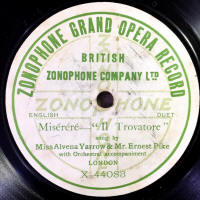These cost 9d each and were available from August 1905 until (I think) early 1906.
|
Michael Thomas' Website |
Records |
| Home Page | Records | British Dance Bands | Sound Files | Contact Me |
|
Originally an
American company, the Zonophone name was bought by the Gramophone
Company in 1903 and they started issuing single-sided 5½", 7", 10" and
12" discs. In 1913, the name was applied to the double-sided
records which had been called "Twin" and both names appeared on the
label for some years. In 1932, when Columbia & the Gramophone Company
were merged to form EMI, Zonophone was once again paired with an existing
label and Regal-Zonophone was born. This survived until 1948. The name
was revived in the 1960s (by EMI). I won't be posting a label listing here as the CLPGS have published full Zonophone listings. However, I want to show the different label designs and try and work out what period they cover. Remember that repressings of earlier issues will have the latest label design, so the highest number of any design is what helps to determine when the changeover happened. It is also not unusual to find records with different designs on each size. Obviously Zonophone were instructed not to waste any old labels! |
|
This is an example of a
5½" inch record. As you can
see, the information given is pretty basic; not even the artists name or
whether it is a song or a cornet solo. This is not unusual for the
period, though. These cost 9d each and were available from August 1905 until (I think) early 1906. |
| This is a standard 10" single-sided record. The 7" and 12" records used an identical design. This design would be in use from early on until March 1908. In March 1904 the records cost 2/- (7") and 4/- (10") reducing to 1/6 and 3/- respectively in July 1904. In 1906 prices were reduced again to 1/- (7") and 2/- (10"). |
|
This double-sided record commemorating the
Coronation of King George V dates from 1911, of course, but interesting
to note that it wasn't deleted from the catalogue until 1922. It is
described as a "Puzzle Plate" and each side has three interleaved
grooves, all starting from different places on the rim. (Note also the
term "plate" for a disc record). The 2nd image of the same recording (thanks to Adam Miller for this one) is most likely to be from during WWI, when it became labelled "Patriotic". It would be interesting to know what the label design was in the post-WWI issues! |
|
In May 1911, Zonophone purchased
the "Twin" trademark and started producing double-sided records with
this new label design. All single-sided records were abandoned at this
point. The earliest true Zonophone-Twin was No. 416, but any Twin
records still in the catalogue would have been re-pressed with the
new Zonophone label. Also there was a final "Twin" release using numbers
566 - 570. This design was in use until June 1920, the highest number being 2016. |
| An
example of the Zonophone Grand Opera label. This is early and is a single
sided record. I would be interested in examples of any other designs for
this series. Thanks to Adam Miller for this image. |
 |
Page last updated on:
February 20, 2025